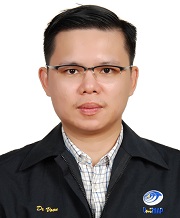
Associate Professor Voon Chun Hong
Universiti Malaysia Perlis, Malaysia
Title: Welding of Thermoplastic using Silicon Carbide Nanomaterials as Susceptor by Microwave Heating
Abstract:
Traditional joining methods for thermoplastics, such as hot tools, friction, ultrasonic, and laser welding, often face limitations including geometric restrictions, small joining areas, and the necessity for skilled operators. These methods can also be energy-intensive and less environmentally friendly. Microwave welding of thermoplastics represents an innovative technique that leverages the unique properties of microwave volumetric heating. Currently available susceptors for microwave welding include carbon-based materials and conductive polymers. While carbon-based materials are effective in absorbing microwave energy, they pose significant health hazards and have low magnetic loss, making impedance matching challenging. Conductive polymers, on the other hand, require additional acidic doping, which adds to the processing time and complexity. To address these limitations, we propose using silicon carbide nanowhiskers (SiCNWs) due to their superior dielectric properties, thermal stability, and mechanical strength. Our research systematically investigated the effects of various parameters, such as heating duration, solid loading of SiCNWs, microwave power, and clamping pressure, on the mechanical properties of the welded joints. Optimal conditions were identified, resulting in maximum tensile and flexural strengths of 2.21 MPa and 8.62 MPa, respectively, for SiCNWs suspension. Furthermore, the introduction of SiCNWs/PMMA nanocomposite thin films as susceptors demonstrated improved joint properties, achieving tensile and flexural strengths of 2.66 MPa and 12.28 MPa. To enhance the compatibility between SiCNWs and polypropylene (PP), surface modification of SiCNWs using silane coupling agents was performed. This modification significantly improved the interfacial bonding and mechanical properties of the welded joints. Our findings indicate that microwave welding using SiCNWs, particularly in nanocomposite thin film form, is a highly effective method for joining thermoplastics, offering a safer, more efficient, and environmentally friendly alternative to conventional methods. This research not only contributes to the field of composite materials but also opens new avenues for industrial applications.
Biography:
Assoc. Prof. Dr. Voon Chun Hong is an associate professor at Institute of Nano Electronic Engineering (INEE), Universiti Malaysia Perlis, Malaysia. He is the author of 65 ISI indexed articles, 21 Scopus indexed articles, 62 Scopus indexed conference proceedings and 7 book chapters. His Scopus H-index is 27 with a total citation of 3,418. He was also included in the 2023 World's Top 2% Scientists by Stanford University. He serves as the Editor in Chief for Scopus and WOS indexed journal, The International Journal of Nanoelectronics and Materials (IJNeaM, 2023 Impact factor: 0.7 Q4). He actively participated in many international conferences as invited speaker and keynote speaker.